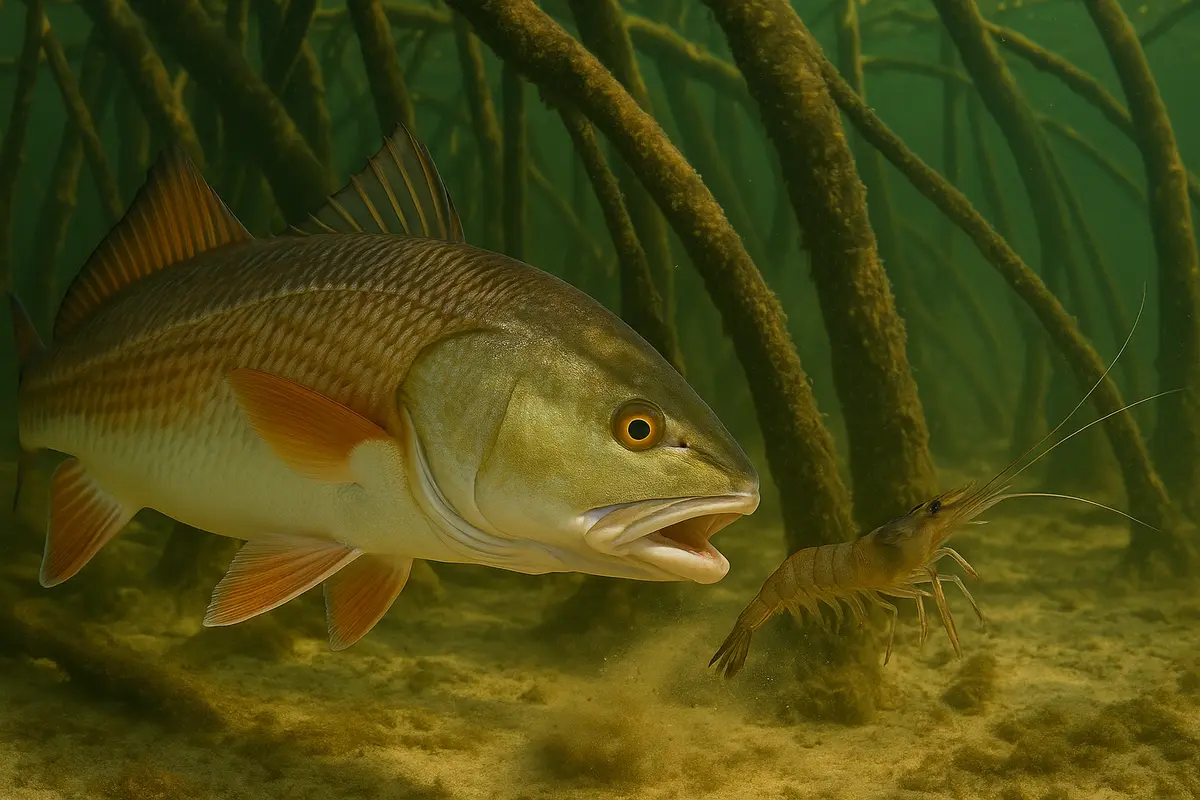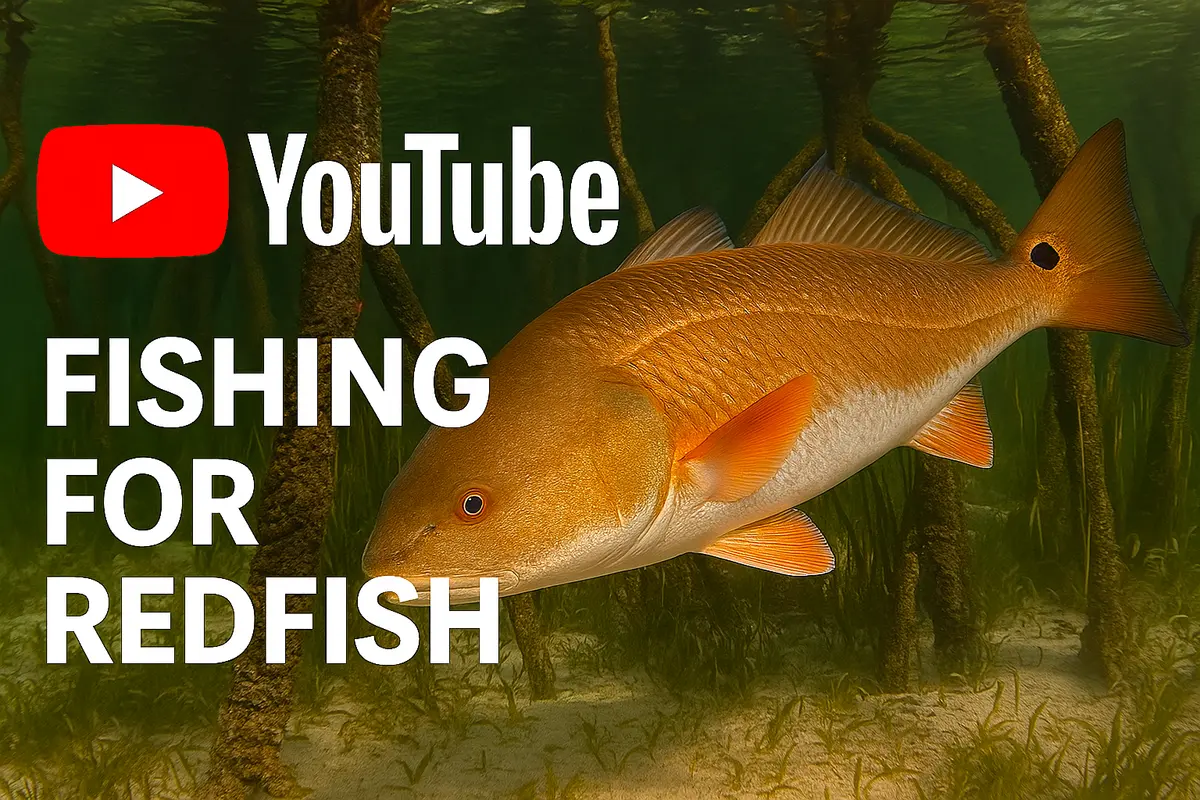Redfish: Habitats - Mangroves
Table of Contents
- Redfish: Habitats – Mangroves
- The Anatomy of Mangroves and Why They Hold Redfish
- 1. Prop Roots and Underwater Tangles
- 2. Shaded Shorelines and Overhangs
- 3. Creek Mouths and Backwater Lagoons
- 4. Mangrove Edges and Oyster Points
- 5. Fallen Branches and Storm Debris
- Redfish Positioning Relative to Tides and Currents
- Environmental Variables That Turn the Bite
- Water Temperature
- Water Clarity
- Seasonal Movements
- Wind and Weather
- Fighting Redfish in the Mangroves: Preventing Break-Offs & Extracting Fish
- 1. Preventing Break-Offs
- 2. Extracting Redfish from Mangrove Roots
- 3. Letting the Fish Swim Free (When All Else Fails)
- 🎣 Redfish Mangrove Hotspots: Florida Case Studies
- 1. Everglades National Park
- 2. Indian River Lagoon
- 3. Tampa Bay Mangrove Shorelines
- 🎥 Recommended Video
- 🧰 Recommended Gear for Redfish in Mangroves
- Tackle Blueprint for Mangrove Redfish
- Four Mangrove Bait Strategies & Rigs
- Presentation Techniques That Fool Mangrove Reds
- Skipping Baits
- Shadow Line Drifting
- Creek Mouth Ambush
- Root Pocket Drop
- Community Wisdom & Expert Tips
- Fine-Tuning Your Strategy by Season
- Winter: Sunny Banks and Muddy Pockets
- Spring: Aggressive, Shallow Feeders
- Summer: Beat the Heat
- Fall: Feeding Frenzy
Redfish: Habitats – Mangroves
Redfish—also known as red drum—are legendary for their ability to thrive in the tangled, tidal maze of mangrove shorelines. Mangrove habitats offer shade, food, shelter from predators, and ambush points for feeding. Understanding how redfish use mangroves can elevate your strategy from blind casting to targeted stalking.
The Anatomy of Mangroves and Why They Hold Redfish
1. Prop Roots and Underwater Tangles
Mangrove roots form dense underwater fortresses. Juvenile redfish tuck deep among these roots for protection, while larger fish work the periphery. Roots are covered in oysters, mussels, and algae that attract crabs, shrimp, and baitfish—turning every tide cycle into a redfish buffet. Sight-fish the shadow lines and pockets between roots at higher tides.
2. Shaded Shorelines and Overhangs
The thick canopy of red mangroves creates dappled shade along the edge. Redfish patrol just inside these shade lines, ambushing mullet, mud minnows, or shrimp swept past on moving water. Focus on natural points, bends, and where overhanging branches meet open water.
3. Creek Mouths and Backwater Lagoons
Where tidal creeks spill into the main bay, nutrient flows fuel mangrove ecosystems. Redfish stack near the mouths, waiting for bait to flush with the tide. Flooded backwater lagoons inside the mangrove forest often host roaming schools of smaller reds on a rising tide.
4. Mangrove Edges and Oyster Points
Where mangrove roots meet oyster bars or rocky outcrops, redfish gather to forage. The irregular bottom and change in structure create feeding lanes. Target the edges at peak tide or as water starts to fall, concentrating prey.
5. Fallen Branches and Storm Debris
Downed branches and storm-blown debris create micro-habitats along the mangrove edge. These "crab condos" become high-value ambush spots, especially at slack or falling tide.
Redfish Positioning Relative to Tides and Currents
| Tide Stage | Likely Redfish Station | Why Redfish Hold Here |
|---|---|---|
| Flood tide | Deep into flooded mangroves | Access to prey hidden in roots; less pressure from predators. |
| High slack | Under heavy overhangs, root pockets | Shade and cooler water; baitfish pinned by water level. |
| First ebb | Creek mouths, mangrove edge points | Bait flushed from roots; ambush along retreating waterline. |
| Low slack | Deeper potholes near mangrove edge | Resting and digesting, waiting for water to return. |
Reading a Mangrove Shoreline
Look for subtle wakes, dimples, or the flicker of tails as redfish move in and out of cover. On clear days, polarized sunglasses help reveal fish ghosting between roots. On windy or high-turbidity days, focus on audible signs—slurps, pops, or the crash of mullet fleeing.
Environmental Variables That Turn the Bite
Water Temperature
Redfish are hardy, but mangrove fish prefer 68–84 °F. In hot weather, the shade and aeration of the roots keep water temps stable. During cold snaps, redfish drop into deeper holes at creek mouths.
Water Clarity
After heavy rains, mangrove shorelines get muddy—perfect for redfish. Stained water lets them feed boldly, especially on cut bait or scented lures. In ultra-clear water, scale down leader and present baits softly.
Seasonal Movements
- Winter: Redfish hunker in muddy backwaters and sunny shorelines for warmth.
- Spring: Warming tides bring schools shallow; crustaceans are key.
- Summer: Early mornings and dusk are best; shade is critical.
- Fall: Reds feast on migrating bait; look for aggressive surface action.
Wind and Weather
Blustery days pile up bait against windward mangrove edges. Cloud cover encourages redfish to roam out from under thick roots.
Fighting Redfish in the Mangroves: Preventing Break-Offs & Extracting Fish
Mangroves are a redfish’s fortress—full of razor-sharp roots and hidden snags. Employ these tactics to both avoid and escape from the tangled mess:
1. Preventing Break-Offs
- Maintain Constant Pressure
Keep steady tension on the fish; never let the line go slack, or the fish will circle into the roots. - Feather Your Drag
Use your thumb (or lightly adjust your reel) to smooth out sudden runs. This softens shock loads on braid and leader. - Angle Rod Away from Cover
Point the rod tip down and out, steering the fish toward open water rather than back into structure. - Use a Shock Tippet
Tie in a 6–10 ft section of 30–40 lb mono between braid and fluoro to absorb sudden surges and protect against abrasion.
2. Extracting Redfish from Mangrove Roots
- Back-Troll with Power
If you’re in a kayak or skiff, engage reverse throttle gently while keeping tension on the line. This can coax the fish out of tight spots. - Strip Line by Hand
Under high tension, strip line in slowly with your hand—this avoids spool freeze and lets you feel root contact so you can pull at the optimal angle. - Side-Pressure Steering
Apply lateral pressure: a quick, firm sweep of the rod to one side can dislodge the fish from tangled roots without increasing line break risk. - Slow, Controlled Gains
Rather than yanking, take small “wins”—pull a few feet, hold, then pull again. This prevents sudden jolts that could snap leader or braid.
3. Letting the Fish Swim Free (When All Else Fails)
Sometimes the only way out is to open your bail and let the redfish free-run:
- Why It Works
A charging fish can clear roots quicker than you can force it. Letting it run straight out creates a clear path. - How to Do It
- Flip the bail and keep your rod tip high to avoid backlashes.
- Watch its direction closely—if it veers toward cover again, close the bail and resume controlled pressure.
- Once in open water, re‐engage drag and calmly reel to regain line and prepare for the final fight.
- Caveat
Only use this on well-set hooks; if you’re unsure of hook‐set quality, avoid risking a loose fish by full bail opening.
🎣 Redfish Mangrove Hotspots: Florida Case Studies
1. Everglades National Park
- Location: Southern tip of Florida, sprawling mangrove wilderness
- Features: Countless creeks, sheltered bays, labyrinthine root systems
- Best Season: Fall through early spring
- Techniques:
- Weedless soft plastics skipped under overhangs
- Live shrimp or cut bait fished along root tangles
- Poling or kayaking to access untouched shorelines
- References:
2. Indian River Lagoon
- Location: East-Central Florida, stretching over 150 miles
- Features: Shallow flats bordered by lush mangroves and oyster bars
- Best Season: Spring through early fall
- Techniques:
- Topwater plugs at dawn along mangrove points
- Suspended twitch baits in creeks and channel edges
- References:
3. Tampa Bay Mangrove Shorelines
- Location: West-Central Florida, urban and wild mangrove stretches
- Features: Mix of natural and restored mangrove habitat, creek mouths
- Best Season: Year-round, peak in late summer/fall
- Techniques:
- Sight-fishing reds cruising mangrove tunnels at high tide
- Cut mullet or pinfish under popping corks at edge breaks
- References:
🎥 Recommended Video
For a visual masterclass in redfish mangrove fishing:
🧰 Recommended Gear for Redfish in Mangroves
- Spinning Combos:
- 7′ medium-heavy, fast-action rod with 3000–4000 size reel
- 15–20 lb braid, 20–30 lb fluorocarbon leader (shorten for clear water)
- Lures:
- Weedless soft plastics (paddletails, shrimp imitations)
- Topwater walk-the-dog plugs
- Scented jerkbaits
- Live Baits:
- Live shrimp, finger mullet, mud minnows
- Apparel:
- Sun shirt, neck gaiter, polarized sunglasses, water shoes
Tackle Blueprint for Mangrove Redfish
| Component | Specification | Purpose |
|---|---|---|
| Rod | 7′ medium-heavy, fast action graphite spin rod | Strength to turn fish from roots |
| Reel | 3000–4000 size saltwater spinner | 15–20 lb braid, strong drag |
| Leader | 20–30 lb fluorocarbon | Abrasion resistance against oysters/roots |
| Hooks | 3/0–4/0 weedless worm or circle hooks | Weedless rigging for skipping into cover |
| Lures | 3–5″ soft plastic jerkbaits, paddletails | Natural movement, skip under overhangs |
Four Mangrove Bait Strategies & Rigs
| Bait Type | Rig | Presentation Secrets |
|---|---|---|
| Live Shrimp | Weedless circle hook, no weight | Skip deep under overhang, let free-fall |
| Cut Mullet | 1/4 oz jighead, weedless hook | Cast to mangrove edge on outgoing tide |
| Soft Plastic | Weighted weedless EWG swimbait hook | Twitch and pause along shade lines |
| Crab | Small circle hook, light split shot | Drop at creek mouths, especially on flood |
Presentation Techniques That Fool Mangrove Reds
Skipping Baits
Use spinning gear to skip soft plastics or live baits deep beneath overhangs. The farther back you reach, the less pressured the fish.
Shadow Line Drifting
Present your lure or bait right along the shadow edge at high tide. Keep rod tip low and retrieve with twitches and pauses.
Creek Mouth Ambush
Anchor near the mouth of a tidal creek as water falls. Cast up-current and drift baits or lures with the outgoing flow.
Root Pocket Drop
Drop weedless rigs vertically into visible gaps in the roots. Pause and lightly jig to trigger strikes from fish lying in ambush.
Community Wisdom & Expert Tips
- “Fish deeper than you can see.” Reds often hold just inside the roots—out of view but always watching.
- Stealth wins. Push-pole, drift, or kayak when possible; avoid trolling motors or loud anchor drops.
- Check tides. The biggest fish often move shallow only at peak flood, then drop back out.
- Sight or sound? On murky days, listen for slurps or surface pops to locate feeding fish.
- Handle with care. Wet hands before handling; minimize time out of water to protect the slime coat and ensure a healthy release.
Fine-Tuning Your Strategy by Season
Winter: Sunny Banks and Muddy Pockets
Fish the warmest, sunlit shorelines and deep creek bends. Slow presentations are key.
Spring: Aggressive, Shallow Feeders
Look for wakes and tailers on the first rising tides. Crustacean imitations excel.
Summer: Beat the Heat
Dawn and dusk are prime. Fish deeper when midday sun is high.
Fall: Feeding Frenzy
Reds bulk up for winter. Cover water and use larger bait presentations.
Click the thumbnail above for a detailed walk-through on mangrove redfishing.
Ask AI for More Info
Try our AI assistant for free—sign up to access this powerful feature.
👉 Sign Up to Ask AI
